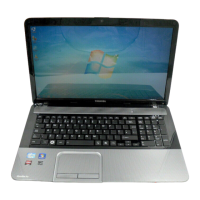
Do you have a question about the Toshiba Satellite L850 Series and is the answer not in the manual?
| Display Size | 15.6 inches |
|---|---|
| Resolution | 1366 x 768 pixels |
| Optical Drive | DVD SuperMulti Drive |
| Connectivity | Wi-Fi 802.11 b/g/n, Bluetooth 4.0 |
| Processor | Intel Core i3, i5, or i7 |
| RAM | Up to 8GB |
| Storage | 500GB/750GB/1TB HDD |
| Graphics | Intel HD Graphics or AMD Radeon HD 7670M |
| Operating System | Windows 7 or Windows 8 |
| Battery | 6-cell lithium-ion |
| Ports | USB 2.0, USB 3.0, HDMI, VGA, Ethernet, headphone/microphone combo jack |
| Card Reader | SD card reader |
| Webcam | HD webcam |
Legal notices, copyright, and trademark information for the manual and product.
Compliance with national and international regulations, including FCC and CE standards.
Licensing information for video standards used in the product.
Details regarding the licensing of the OpenSSL toolkit software.
Information on the computer's compliance with ENERGY STAR energy efficiency guidelines.
Guidelines for the proper disposal of the computer and its batteries according to environmental regulations.
Safety precautions related to the use of the optical disc drive and laser system.
General safety advice for computer use, handling, and environmental considerations.
A list of items to verify are included with your new computer.
Explains the formatting and symbols used throughout the manual for clarity.
Step-by-step guide for initial setup and operation of the computer.
Instructions on how to properly shut down, restart, or put the computer into sleep/hibernation modes.
Identification of components on the front of the computer with the display closed.
Identification of ports and connectors on the left side of the computer.
Identification of ports and connectors on the right side of the computer.
Identification of components located on the back of the computer.
Identification of components on the underside of the computer.
Identification of components on the front of the computer with the display open.
Details on the computer's internal hardware like CPU, HDD, and memory.
Explanation of power indicators and battery status based on LED behavior.
Summary of the computer's physical, environmental, and power requirements.
Description of the keyboard layout, keys, and indicators like Caps Lock and Num Lock.
Explanation of function keys (F1-F12) and their use with the FN key for special features.
Information on supported optical disc formats and how to use the drives.
Details on types of writable discs (CDs, DVDs, Blu-ray) and their formats.
Notes and limitations on using the software for DVD and video playback.
Notes and limitations on using the software for Blu-ray disc playback.
Information on 3D playback capabilities and requirements for external devices.
Overview of wireless communication functions like Wireless LAN and Bluetooth.
Instructions for connecting and configuring the computer's Local Area Network (LAN) interface.
Details on battery types, usage, charging, and maintenance for optimal life.
Instructions on how to install and remove additional memory modules for performance enhancement.
Information on connecting and using peripheral devices like memory media and external monitors.
Steps and considerations for connecting an external analog monitor to the computer.
Instructions for connecting HDMI display devices and configuring display settings.
List of optional accessories available to enhance computer functionality.
Description of audio control functions like Volume Mixer and sound enhancements.
Description of pre-installed software utilities and how to start them.
Overview of unique or advanced features that enhance computer usability.
Guide to setting up user and supervisor passwords for computer security.
Instructions for configuring various system settings and options.
Details on enabling/disabling USB charging and power management features.
Settings for USB charging behavior when the computer is running on battery power.
Options for customizing display settings for internal or external monitors.
Configuration for selecting the display output device when starting the computer.
Options for modifying system boot settings, including boot priority and speed.
Guidelines for diagnosing and resolving computer issues effectively.
Basic checks for common problems before in-depth troubleshooting.
Techniques for identifying the cause of malfunctions by observing system behavior.
Troubleshooting steps for problems related to software, applications, and error messages.
Steps to check hardware configuration and identify component or peripheral failures.
Solutions for frequently encountered issues like program freezes, startup failures, and hardware malfunctions.
Detailed troubleshooting for specific computer components and systems.
Information on how to contact TOSHIBA for technical assistance and support.











